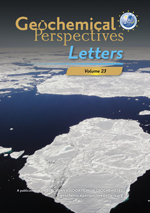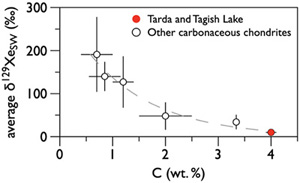 | Origin of radiogenic 129Xe variations in carbonaceous chondrites Abstract: Carbonaceous chondrites are pristine witnesses of the formation of the solar system. Among them, the carbon-rich Tarda and Tagish Lake meteorites are thought to have sampled very distant regions of the outer circumsolar disk (Hiroi et al., 2001 Hiroi, T., Zolensky, M.E., Pieters, C.M. (2001) The Tagish Lake Meteorite: A Possible Sample from a D-Type Asteroid. Science 293, 2234–2236. https://doi.org/10.1126/science.1063734 ). Here, we show that their noble gas isotopic compositions (especially 129Xe excesses) are similar, implying their formation in comparable environments. Combined with literature data, we show that the radiogenic excesses of 129Xe relative to solar wind in carbonaceous chondrites define anti-correlations with their respective iodine and carbon contents. These trends do not result from the heterogeneous distribution of 129I in the disk but rather evidence a xenon dilution effect; the radiogenic 129Xe excesses being dominated by trapped xenon in the most carbon-rich carbonaceous chondrites. Our data also suggest that both Tarda and Tagish Lake accreted beyond 10 astronomical units, in regions of the disk that were cold enough for CO2 to condense. |
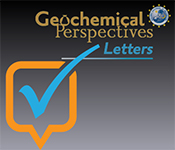 | Corrigendum to “Equilibrium olivine-melt Mg isotopic fractionation explains high δ26Mg values in arc lavas” by Liu et al., 2022 |
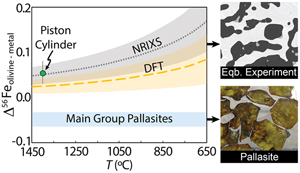 | Iron isotope evidence of an impact origin for main-group pallasites Abstract: Despite decades of work, the origin of pallasite meteorites has remained enigmatic. Long thought to be samples of the core-mantle boundary of differentiated asteroids, more recent studies have suggested a range of mechanisms for pallasite formation. These include olivine-metal mixing during a planetesimal collision and the intrusion of over-pressured core liquids into a planetesimal mantle. Establishing if the olivine and metal that comprise pallasites were once equilibrated at high temperature remains key to discriminating between these hypotheses. To this end, we determined the iron isotope compositions of olivine and metal in eleven main-group pallasites and found, in all cases, that olivine is isotopically lighter than metal. To interpret these data, we constrained the olivine-metal equilibrium Fe isotope fractionation with ab initio calculations and high temperature experiments. These independent approaches show that olivine preferentially incorporates the heavy isotopes of iron relative to metal. Our results demonstrate that pallasitic olivine and metal never achieved isotopic equilibrium with respect to iron. This precludes extended cooling at high temperature and is best reconciled with an impact origin for the main-group pallasites. |
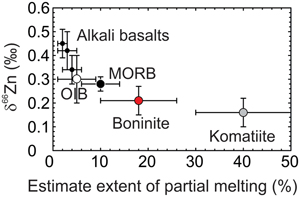 | A partial melting control on the Zn isotope composition of basalts Abstract: Basaltic partial melts are produced in a range of tectonic settings, including fluid-assisted melting above subduction zones, decompression melting at ridges and thermally driven melting above mantle plumes. To examine the role of partial melting on Zn, isotope and abundance data are reported for modern large-degree partial melts of the mantle represented by 22 mid-ocean ridge basalts (MORB) from three ocean basins and the first data for boninites. Boninites have some of the lowest Zn abundances of all terrestrial basalts and Zn isotope compositions (δ66Zn = +0.21 ± 0.06 ‰), generally lighter than for MORB (δ66Zn = +0.28 ± 0.06 ‰). Accounting for partial melting, komatiites, boninites and MORB derive from mantle sources with δ66Zn of ∼0.16 ± 0.06 ‰. Lower-degree partial melts, such as alkali basalts, can have higher δ66Zn, with up to ∼0.4 ‰ variation possible from partial melting of distinct peridotite mantle sources. Partial melting of fertile lherzolitic and depleted harzburgitic mantle sources can generate significant Zn isotope variability and should be evaluated prior to ascribing crustal, enriched or lithological components to mantle reservoirs from Zn compositions of planetary basalts. |
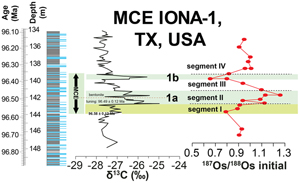 | Enhanced continental weathering activity at the onset of the mid-Cenomanian Event (MCE) Abstract: The emplacement of a Large Igneous Province (LIP) is implicated in the triggering of the Cenomanian-Turonian Oceanic Anoxic Event 2 (OAE 2). Evidence for a similar initiation mechanism for the mid-Cenomanian Event (MCE) is unclear. In this study, a reconstruction of mid-Cenomanian seawater 187Os/188Os, the first for the Western Interior Seaway, tests the competing roles of LIP versus continental weathering activity in triggering the MCE. The absence of a prolonged unradiogenic Os isotope excursion (low 187Os/188Os) at the onset of the MCE interval argues against LIP involvement in the event’s initiation. Rather, more radiogenic 187Os/188Os at the onset, that continues to rise to the middle of the MCE, indicates that the event was triggered by increased continental weathering. The combination of decreasing 187Os/188Os from the middle of the MCE onward, coincident with a 40Ar/39Ar age of 96.4 Ma of basalts from Ellesmere Island, Canada, is consistent with High Arctic LIP-related volcanic activity that may have contributed to the end of the MCE. These new data on the MCE thus indicate that LIP activity is not always the trigger for carbon cycle perturbation and associated climate change. |
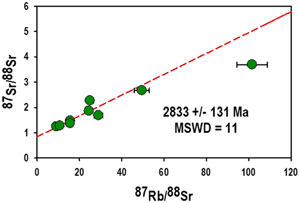 | Archean age and radiogenic source for the world’s oldest emeralds Abstract: New 87Rb-87Sr data are reported for emeralds from Gravelotte, South Africa and Muzo, Colombia, the first such data in 30 years. The Gravelotte deposit is inferred to be the world’s oldest emerald deposit from the ∼2.97 Ga U-Pb age of the associated pegmatite. The majority of Gravelotte emeralds plot on an 87Rb-87Sr errorchron with an age of 2883 ± 131 Ma, close to the pegmatite age, demonstrating that the emeralds are Mesoarchean in age. The Muzo emerald data, when combined with data from nearby Colombian emerald deposits, define an age of ∼48 Ma, younger than muscovite Ar-Ar ages (65–62 Ma), likely reflecting the resetting of 87Rb-87Sr in some emeralds. The initial Sr isotopic composition for Gravelotte emeralds is radiogenic (87Sr/86Sri = 0.841), and their trace element signatures support their formation from a mature, high Rb/Sr, felsic continental crustal protolith in the Mesoarchean. Direct 87Rb-87Sr dating of emeralds holds promise for offering constraints on both mineralisation ages and source compositions. |
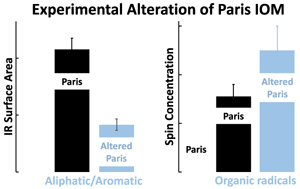 | Preservation of the isotope signatures in chondritic IOM during aqueous alteration Abstract: Mighei-type carbonaceous chondrites (CM) figure among the most primitive objects in the solar system. Yet, they all have experienced various degrees of aqueous alteration having modified their insoluble organic matter (IOM), in a sequence that remains to be accurately constrained. Here, we exposed the IOM of Paris, the least altered CM available, to hydrothermal conditions at 150 °C for 49 days and compared the experimental residue to the IOM of two altered CMs likely originating from the same parent body as Paris, namely Aguas Zarcas and Mukundpura. The experimental residue shows a chemical and isotopic composition similar to those of Aguas Zarcas and Mukundpura IOMs, confirming that these CMs can be seen as altered counterparts of Paris. The abundance of organic radicals also increases significantly during the experiment. Isotopic hotspots do not seem to have been lost during the experiment, suggesting that the hotspots generally observed within the CM IOMs may date back from pre-accretion era. Of note, the Raman signature of the residue differs from that of the CM IOMs, highlighting the need for further experiments better mimicking asteroidal-like conditions. |
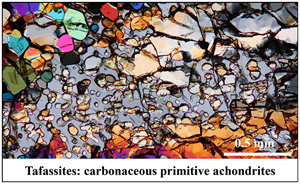 | Early formation of primitive achondrites in an outer region of the protoplanetary disc Abstract: We compare 13 Tafassasset-related meteorites and propose that they form the first meteorite group of carbonaceous primitive achondrites. We name this new group the Tafassites, which form a continuum from equilibrated petrological type 6 chondrites (termed T6) to partially molten type 7 primitive achondrites (T7) and bear carbonaceous meteorite-like (C) mass-independent isotopic signatures. We use SIMS Pb–Pb Ca phosphate ages to model the Tafassite parent body (TPB) accretion at 1.1+0.3−0.4 Myr before rapid cooling to below ∼720 K within ∼9.0 ± 5.0 Myr after CAI formation, respectively. This scenario is consistent with other primitive achondrites but incompatible with a commonly assumed CR chondrite parent body, which was constrained by Al–Mg, Hf–W, and Pb–Pb chondrule ages up to >3.7 Myr after CAIs. Given their carbonaceous-like affinity, Tafassites therefore constitute the first early accreted chondritic meteorite group from an outer region of the protoplanetary disc, presumably close to the further CR feeding zone. Our findings support that planetary formation in the outer protoplanetary disc evolved nearly coevally with the inner part of the disc, with limited admixing of inward material during planetesimal formation over 4 million years after CAIs. |
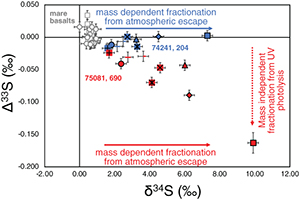 | Isotopic evidence of sulfur photochemistry during lunar regolith formation Abstract: Lunar gardening results in volatile mobilisation and stable isotopic fractionations that are mass dependent. An unambiguous role for mass independent fractionation (MIF), such as that produced by photochemistry, has not been demonstrated on the Moon. We observe MIF for sulfur isotopes in lunar soil 75081, 690 while MIF is not observed in soil 74241, 204. The MIF is likely generated after sulfur is volatilised during soil maturation processes. The isotopic discrepancy between 75081, 690 and 74241, 204 may reflect differences in photochemistry, such as illumination or in generation of photochemically active volatile sulfur species, for instance, due to varying H contents from solar wind implantation. |
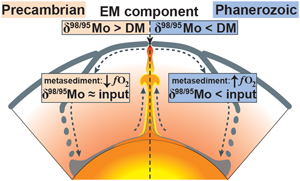 | Molybdenum isotopes in plume-influenced MORBs reveal recycling of ancient anoxic sediments Abstract: Under modern oxidising Earth surface conditions, dehydrated subducted slabs show Mo isotope compositions as low as δ98/95Mo = −1.5 ‰, compared to the depleted mantle δ98/95Mo = −0.2 ‰. Such light Mo isotope compositions reflect the redox-dependent aqueous mobility of isotopically heavy Mo associated with slab dehydration. Here we analysed basaltic glasses from the South-Mid Atlantic Ridge, whose parental melts are influenced by the enriched Discovery and Shona mantle plumes. We report increasingly higher δ98/95Mo of up to −0.1 ‰ from the most depleted samples towards those tapping more enriched mantle sources. δ98/95Mo values correlate with radiogenic Sr and Nd isotopes, which indicates the recycling of Proterozoic sediments with a Mo isotopic composition that was not affected by subduction-related, oxic dehydration. We propose that the Mo isotope signatures were retained during subduction and reflect anoxic conditions during deep sea sedimentation in the mid-Proterozoic. Finally, Mo isotope fractionation between different terrestrial reservoirs likely depends on the slab redox budget, and therefore on the timing of subduction with regard to Earth’s surface oxygenation. |
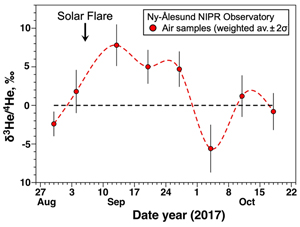 | Sun flare activity may solve unknown source of helium-3 in the atmosphere Abstract: Helium abundance measurements in the atmosphere suggest a supply of crustal 4He from natural gas extraction since the beginning of the 20th century. However, the 3He/4He ratio of air appears near constant, which calls for an unknown source of 3He to compensate for the contribution of anthropogenic 4He to the atmosphere. Knowing the origin and cycle of 3He in the atmosphere is important, being also an important resource in nuclear fusion reactors and for cryogenic applications. Here, we report 3He/4He variations measured during the massive X9.3 solar flare event of September 6th 2017 in Ny-Ålesund, Svalbard islands, near the North Pole. The solar wind was expected to reach the Earth on September 8th. A total of five samples, collected immediately after the solar flare event, showed an excess of 3He, up to 5.5 ± 1.7 ‰ (δ3He), compared to the terrestrial atmospheric isotopic value. If the solar wind, enhanced by solar flares, was fed into the atmosphere by auroral precipitation, it would increase the polar atmospheric helium isotope ratio. The helium would then be diluted by diffusion and the excess 3He would rapidly disappear. Thus, 3He excess supplied by these events may keep the atmospheric 3He/4He constant. |
<< Previous issueNext issue >>





